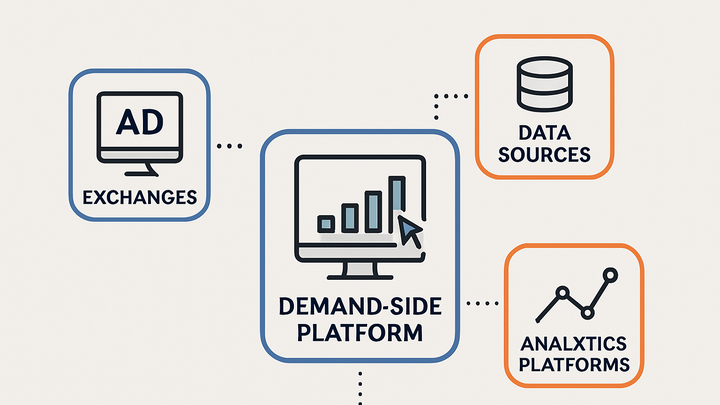Published on 2025-06-26T04:27:04Z
What is a Demand-Side Platform (DSP)? Examples and Insights
A Demand-Side Platform (DSP) is a programmatic advertising technology that allows marketers and agencies to purchase digital ad inventory across multiple ad exchanges from a single interface. DSPs automate the buying process through real-time bidding (RTB), optimizing bids based on audience data, performance goals, and budget constraints. By centralizing access to ad inventory and leveraging advanced targeting capabilities, DSPs help advertisers reach the right audience at scale while improving efficiency and cost-effectiveness. Integrations with analytics platforms like PlainSignal and Google Analytics 4 (GA4) enable detailed performance tracking and optimization. This glossary article explores the definition, workings, benefits, and implementation best practices for Demand-Side Platforms.
Demand-side platform (dsp)
A DSP is a platform that automates the real-time purchase of digital ad inventory, optimizing for targeting and performance.
Overview of Demand-Side Platforms
A DSP provides a single interface for advertisers to buy ad impressions across multiple ad exchanges and networks. It integrates data, bidding technology, and campaign management tools to streamline programmatic advertising.
-
Definition
A DSP is an automated platform that enables advertisers to purchase digital ad impressions across multiple ad exchanges in real time, optimizing for targeting, price, and performance.
-
Core components
Most DSPs include several key modules that ensure efficient programmatic ad buying:
-
Bidder module
Handles real-time bidding by evaluating bid requests and submitting bids based on targeting criteria and budget constraints.
-
Data integration layer
Aggregates and processes first- and third-party data to build audience segments and inform bid decisions.
-
User interface
Offers dashboards for campaign setup, audience targeting, and performance reporting.
-
How DSPs Work
DSPs automate the process of buying ad inventory through real-time interactions between advertisers, ad exchanges, and publishers. This process happens in milliseconds every time a user visits a site with available ad space.
-
Real-time bidding (rtb)
When a user visits a website, an ad exchange sends a bid request to connected DSPs. The DSP evaluates the request, matches it against campaign criteria, and submits a bid within milliseconds.
-
Bid request
Sent by the ad exchange and contains information about the user, context, and available ad slot.
-
Bid response
The DSP’s offer outlining the bid price and ad creative.
-
-
Audience targeting
DSPs apply audience segmentation rules such as demographics, interests, or browsing behavior to decide which impressions to bid on.
-
Budget and bid management
Advertisers set budgets and bid strategies. The DSP adjusts bids in real time to maximize performance while staying within budget.
Key Benefits of Using a DSP
By leveraging a DSP, marketers gain access to advanced targeting, scalability, and data-driven optimization not possible with manual ad buys.
-
Efficiency and scale
Centralized access to multiple ad exchanges prevents the need to negotiate individually with publishers, saving time and resources.
-
Advanced targeting
Integration with data providers allows for precise audience segmentation based on demographics, behavior, or contextual signals.
-
Performance tracking and optimization
Real-time analytics and reporting let advertisers measure return on ad spend (ROAS) and adjust campaigns swiftly.
-
Integration with PlainSignal
Use PlainSignal’s cookie-free analytics to track ad-driven traffic without compromising privacy.\n\n
html\n<link rel="preconnect" href="//eu.plainsignal.com/" crossorigin />\n<script defer data-do="yourwebsitedomain.com" data-id="0GQV1xmtzQQ" data-api="//eu.plainsignal.com" src="//cdn.plainsignal.com/plainsignal-min.js"></script>\n -
Integration with GA4
Connect Google Analytics 4 to your DSP campaigns for deeper cross-channel performance insights and conversion tracking.
-
Integrating Analytics with DSPs
Tracking DSP-driven campaigns is essential for measuring impact and optimizing performance across channels. Here’s how to set up analytics integrations using PlainSignal and Google Analytics 4 (GA4).
-
Cookie-free tracking with PlainSignal
PlainSignal offers a privacy-first approach to analytics, capturing essential metrics without cookies. Insert the following snippet into your landing pages to begin tracking:\n\n
html\n<link rel="preconnect" href="//eu.plainsignal.com/" crossorigin />\n<script defer data-do="yourwebsitedomain.com" data-id="0GQV1xmtzQQ" data-api="//eu.plainsignal.com" src="//cdn.plainsignal.com/plainsignal-min.js"></script>\n -
Tracking with google analytics 4 (GA4)
GA4 provides advanced event-based tracking. Add the GA4 tag to your pages to link ad click events to conversions:\n\n
html\n<!-- Global site tag (gtag.js) -->\n<script async src="https://www.googletagmanager.com/gtag/js?id=GA_MEASUREMENT_ID"></script>\n<script>\n window.dataLayer = window.dataLayer || [];\n function gtag(){dataLayer.push(arguments);}\n gtag('js', new Date());\n gtag('config', 'GA_MEASUREMENT_ID');\n</script>\n
Best Practices and Considerations
To maximize the value of a DSP, advertisers should follow industry best practices regarding data privacy, budget allocation, and creative optimization.
-
Privacy and compliance
Ensure your DSP integrations comply with GDPR, CCPA, and other data protection regulations. Use cookie-free or consent-based tracking when required.
-
Budget allocation strategies
Distribute budgets across channels and campaigns based on performance data. Use automated rules to prevent overspending.
-
Creative optimization
Test multiple ad creatives and formats. Leverage dynamic creative optimization features in your DSP to serve personalized ads.
